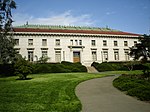Essig Museum of Entomology
The Essig Museum of Entomology is a research museum dedicated to terrestrial arthropods, located at the University of California at Berkeley. It contains perhaps the world's largest collection of California insects and has been ranked among the top university-based collections in North America. The museum is open to the public twice per year (Cal Day and Darwin Day). The museum's origins date back to the 1880s, with the university's earliest teaching collection. After entomologist Edward Oliver Essig joined the faculty in 1914, he began to expand its collections. The research collection, starting with 10,000-15,000 specimens, was formalized in 1939 as part of the California Insect Survey (Experiment Station Project 1205), and in 1972 was named the Essig Museum of Entomology. Historically, the museum's primary geographical emphasis has been on western North America, with a focus on surveying the insects of California. More recently that focus has broadened to the eastern Pacific Rim, particularly Mexico, Costa Rica, Chile, and the Pacific Basin islands.
Excerpt from the Wikipedia article Essig Museum of Entomology (License: CC BY-SA 3.0, Authors).Essig Museum of Entomology
Campanile Way, Berkeley
Geographical coordinates (GPS) Address Nearby Places Show on map
Geographical coordinates (GPS)
| Latitude | Longitude |
|---|---|
| N 37.8713 ° | E -122.2621 ° |
Address
Valley Life Sciences Building (VLSB)
Campanile Way
94704 Berkeley
California, United States
Open on Google Maps








